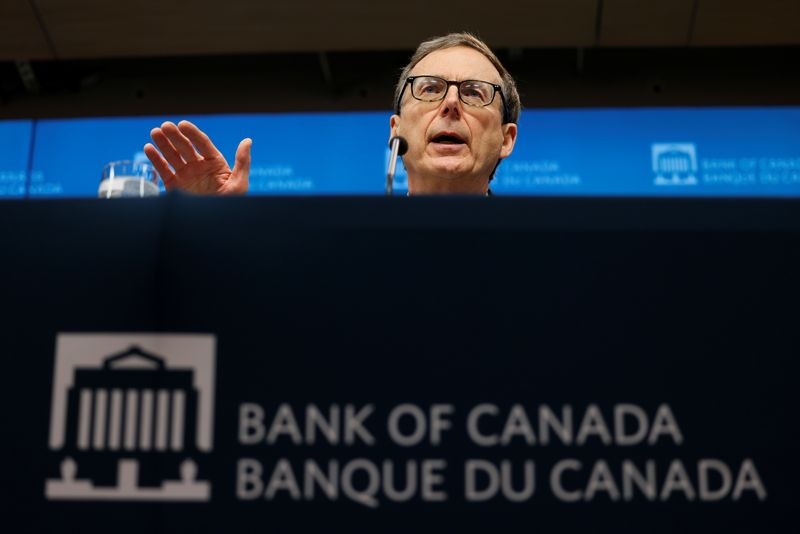By Fergal Smith
TORONTO (Reuters) -The Bank of Canada's unwinding of a pandemic-era stimulus policy could end sooner than expected after a shortage of cash in the financial system forced the central bank to use a key liquidity operation for the first time in four years.
CORRA, the rate at which banks lend funds to each other overnight, has traded above the BoC's 5% target for the overnight rate, or benchmark policy setting, since August of last year.
This month, after CORRA climbed as much as 6 basis points above target, the central bank acted, injecting C$5 billion ($3.7 billion) of liquidity into the market through its overnight repo operations.
Above-target CORRA is a sign that the BoC's quantitative tightening program (QT) is reducing liquidity, analysts say. The Canadian central bank launched QT in April 2022, aiming to reduce the size of its balance sheet after it purchased bonds in large scale to support the economy during the pandemic.
Ending the program, or reducing its pace, could lower borrowing costs and weigh on the Canadian dollar while also leaving less room for the BoC to grow its balance sheet in the future, analysts say.
Governor Tiff Macklem told reporters on Wednesday, after the BoC left rates on hold, that it's too soon to end QT but the central bank will be refining its view on the appropriate size of the balance sheet as the size approaches a previous estimate.
"It's important for the BoC to be able to steer markets toward their policy rate and their credibility is at stake in that regard given where CORRA sits," said Derek Holt, head of capital markets economics at Scotiabank.
"The cleaner solution is to address the root of the problem which is probably that QT is having adverse effects upon funding markets," Holt said.
Under QT, the BoC has been letting bonds roll off its balance sheet without replacement as they mature, with a resulting decline in settlement balances, or the reserves that were created to pay for the bonds.
Settlement balances have fallen to C$112 billion from a peak of C$390 billion in February 2021.
The BoC has guided that QT will run until the end of 2024 or the first half of 2025 when settlement balances will have fallen to a steady-state level, which it estimates to be in a range of C$20 billion to C$60 billion, or roughly 1% to 2% of GDP.
Persistent upward pressure on repo rates could indicate that the steady-state estimate is too low, the central bank says.
"We are already seeing a rather persistent upward pressure on repo rates as reserves fall, and so that likely suggests the 'optimal' level (of reserves) is somewhat higher than initially believed," said Ian Pollick, global head FICC strategy at CIBC Capital Markets.
Pollick sees settlement balances stabilizing near C$80 billion, which could occur around the summer. At RBC Dominion Securities Inc, the estimate for the steady-state level is higher still at about C$100 billion. It expects QT to end by March.
U.S. dealers expect the Federal Reserve to end QT at a later date, in the fourth quarter, but central bank reserves are a much bigger share of the U.S. economy, at about 14% of GDP.
Not all analysts expect above-target CORRA to impact QT but they agree that ending the program could see the BoC begin buying bonds at a rapid clip, with tens of billions of dollars of bonds due to roll off the central bank's balance sheet in the next couple of years.
The BoC's next policy decision is on March 6.

"If they are not open to adjusting QT, then they should explain their plans for the repo book in a more transparent fashion," Holt said. "It's a long path ahead in terms of repo injections if they keep relying upon that tool until the next meeting or the one after that."
($1 = 1.3459 Canadian dollars)